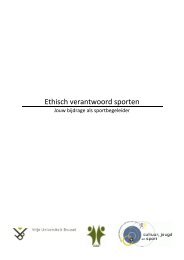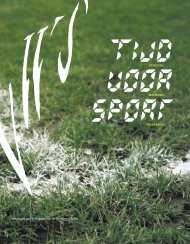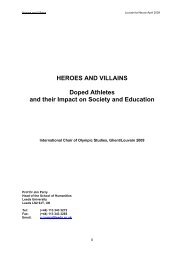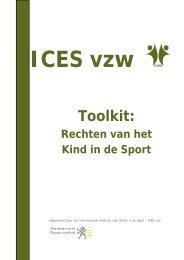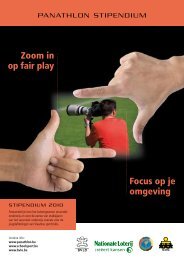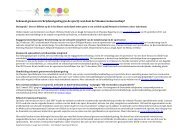interests and independence and the issue of power imbalances, but should also be the major framework for the evaluation of risk factors, the development of behavioural codes and the development and evaluation of preventive policies. Notes 1. Cense, M., Rode kaart of carte blanche Risicofactoren voor seksuele intimidatie en seksueel misbruik in de sport. Onderzoekrapport, 1997. 2. Ibid. 3. Finkelhor, D., Child Sexual Abuse: New theory and research, New York: The Free Press, 1984 and Finkelhor, D., (Ed.) (1986) A Sourcebook on Child Sexual Abuse, London: Sage. 4. Wolf, S.C., A Multi-factor model of deviant sexuality, 1984, paper presented to the Third International Conference on Victimology, Lisbon cited by D. Fisher in T. Morrison, M. Erooga and R.C. Beckett., (Eds.) Sexual Offending Against Children: Assessment and treatment of male abusers, London: Routledge, 1994. 5. Brackenridge, C.H., ‘Fair Play or fair game? Child sexual abuse in sport organisations’, International Review for the Sociology of Sport, 1994, 29, pp. 287-299. 6. Brackenridge, C.H., ‘Educating for child protection in sport’, paper to the Leisure Studies Association Conference, Eastbourne, UK, 12 -14 th September, 1995. 7. Brackenridge, C.H., ‘He owned me basically..’Women’s experience of sexual abuse in sport, International Review for the sociology of Sport, 1997, 32, 2, pp. 115-30. 8. The explanatory model by Cense, M., ibid, is a continuing process – see Brackenridge, C.H., ‘Researching sexual abuse and sexual harassment in sport’, in: G. Clarke and B. Humberstone, (eds.) Researching Women in Sport, London, Macmillan, 1997, and Cense, M. and Brackenridge, C.H., ’Temporal and developmental risk factors for sexual harassment and abuse in sport’, European Physical Education Review, 2001, 7, 1, pp. 61-79. In this chapter terms from the latest developments are used. 9. Cense, M., ibid. 10. Brackenridge, C.H., Spoilsports: Understanding and preventing sexual exploitation in sport, London: Routledge, 2001. 11. Moget, P.C.M. and Weber, M., The independent athlete. Educational guidelines for training and coaching young athletes. NOC*NSF, Internal Publication, 2007. 12. Finkelhor, D., Child Sexual Abuse: New theory and research, New York: The Free Press, 1984 and Finkelhor, D., (ed.) A Sourcebook on Child Sexual Abuse. London, Sage,1986. 13. Brackenridge, C.H., ‘”He owned me basically…” Women’s experience of sexual abuse in sport, International Review for the sociology of Sport, 1997, 32, 2:115-30. 14. Hall, G.C.N. and Hirschman, R., ‘Toward a theory of sexual aggression: A quadripartite model’, Journal of Consulting and Clinical Psychology, 1991, 59, pp. 662-669. 15. Hall, G.C.N., Shondrick, D.D. and Hirschman, R., ‘The role of sexual arousal in sexually aggressive behaviour: A meta-analysis’, Journal of Consulting and Clinical Psychology, 1993, 61, pp. 1091-1095. 16. Moget, P.C.M. and Weber, M., ‘Project Sexual Intimidation in Sport’, NOC*NSF: 1996- 2006. Ethic Perspectives, 2006, 3, pp. 300-311. 17. Hamilton, M., and Yee, L., ‘Rape knowledge and propensity to rape’, Journal of Research in Personality, 1990, 24, pp. 111-122. 38
3.6 Risks and opportunities for sexual exploitation in the Danish sports club system Jan Toftegaard Stoeckel Background Modern sport is often associated with values such as fairness, morality and courage. Sport has also, historically, been one of the most important arenas for teaching children and young people basic moral and social values. However, the notion of sport as a morally pure institution stands in clear contrast to the growing documentation of critical issues such as doping, corruption and coaches’ sexual harassment and abuse of their athletes. The issues of doping and paedophilia have raised questions about the ethical standards in sport and caused a moral panic provoking Danish sports clubs to adopt hurriedly the ’10 recommendations for preventing sexual abuse’ issued by the main sport organisations. Based on assumptions rather than research, these recommendations have tended to put more the focus of attention on individual perpetrator pathology than the complex nature of interpersonal relations in sport. These are negotiated within the context of organisational structures and cultures that allowing the grooming and exploitation of athletes. Whilst sport organisations have reacted to the problem of sexual harassment and abuse by coaches by developing case handling procedures and brochures, fact sheets and recommendations, the responsibility for developing adequate child protection standards has been left entirely with local sports clubs. Until now, the development of child protection strategies or action plans has not been a priority for the national governing bodies in Denmark. Their main argument is that initiatives should correspond to the size of the problem, which is currently perceived to be small. Before the study reported below, no empirical work had been conducted to support or challenge claims about child safety in voluntary youth sport clubs and very little was known about the prevalence of sexual harassment and abuse in sport. Since the mid-1980s researchers from various countries and scientific fields have sought to investigate the scope and context of sexual exploitation in sport. 39
- Page 1 and 2: Part 3 GLOBAL ISSUES: HARASSMENT AN
- Page 3 and 4: It was in the middle of these early
- Page 5 and 6: more likely to be harassed and/or a
- Page 7 and 8: The survey revealed a considerable
- Page 9 and 10: 8. Kirby, S.L. and Greaves, L. ‘F
- Page 11 and 12: Research clearly indicates that rel
- Page 13 and 14: performance. Items thrown by the co
- Page 15 and 16: High Low Figure 3.1 Athletes’ exp
- Page 17 and 18: 3.3 Sexual harassment and abuse in
- Page 19 and 20: variables:1) formation of the sport
- Page 21 and 22: een harassed and abused by a coach.
- Page 23 and 24: The results show that 30% of the st
- Page 25 and 26: 3.4 Sexual abuse of athletes in org
- Page 27 and 28: conversely, to present the perpetra
- Page 29 and 30: staff or volunteers who were not as
- Page 31 and 32: 3.5 Sexual harassment and abuse in
- Page 33 and 34: automatically mean that he/she will
- Page 35 and 36: councilors of NOC*NSF. Solid resear
- Page 37: non-aggressors. Such variables are
- Page 41 and 42: under the three major headings of
- Page 43 and 44: These findings indicated that clubs
- Page 45 and 46: Whilst 8% of sports clubs knew of s
- Page 47 and 48: 3.7 Sexual harassment among female
- Page 49 and 50: slapped on the face, head or ears b
- Page 51 and 52: When I was not getting as good achi
- Page 53 and 54: 3.8 Unwanted sexual experiences in
- Page 55 and 56: 18-21 years old). The VUBrussels sa
- Page 57 and 58: Coach behaviour Perceptions Experie
- Page 59 and 60: However, KULeuven students’ perce
- Page 61 and 62: 7. Leahy, T., Pretty, G., and Tenen
- Page 63 and 64: Nineteen male swimming coaches part
- Page 65 and 66: this study. 14 It is important to n
- Page 67 and 68: Finally, it is important to note th
- Page 69 and 70: 3.10 What price gold medals? An inv
- Page 71 and 72: The research that supported and und
- Page 73 and 74: symptoms. Lastly, this will only oc
- Page 75 and 76: The results from this study may lea
- Page 77: i NIF, Årsrapport 2006 - Norges Id



